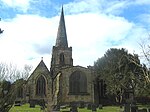Duffield Bank Railway
15 in gauge railways in EnglandLocomotive manufacturers of the United KingdomRail transport in DerbyshireSir Arthur HeywoodUse British English from February 2015

The Duffield Bank Railway was built by Sir Arthur Percival Heywood in the grounds of his house on a hillside overlooking Duffield, Derbyshire in 1874. Although the Ordnance Survey map circa 1880 does not show the railway itself, it does show two tunnels and two signal posts. However, the online map archive of the National Library of Scotland includes a map of 1914 from the 25 inches to the foot series (Derbyshire XLV.9 ) that shows the full extent of the railway.
Excerpt from the Wikipedia article Duffield Bank Railway (License: CC BY-SA 3.0, Authors, Images).Duffield Bank Railway
Squirrel Walk, Amber Valley
Geographical coordinates (GPS) Address Nearby Places Show on map
Geographical coordinates (GPS)
| Latitude | Longitude |
|---|---|
| N 52.983 ° | E -1.4752 ° |
Address
Squirrel Walk 2
DE56 4BH Amber Valley
England, United Kingdom
Open on Google Maps









